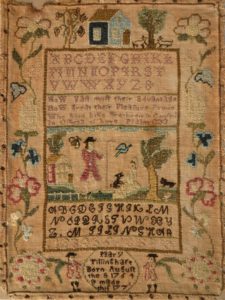‘Their Manners Pleasing, and Their Education Complete’

Sampler, signed “Mary Tillinghast born August the 8 1764 and made this 1772” 01.202, NHS Collection
Samplers were a critical part of women’s education in eighteenth and early-nineteenth-century America. Simple samplers provided training in utilitarian stitches, called plain work, that prepared girls for a lifetime of sewing and mending. More elaborate samplers gave young women the opportunity to practice decorative, or fancy, embroidery—a skill that was associated with elegance and refinement during this era. When finished, a sampler served as evidence that a girl was proficient in plain or fancy needlework. Armed with these skills, many young women went on to sew and embroider clothing and other objects such as wallets, book covers, chair seats, and mourning pictures.
Simple samplers were sometimes made at home, but girls usually worked their samplers in school. Newport was home to a number of academies that instructed pupils in needlework, other ornamental pursuits like painting, music, and dancing, as well as academic subjects like reading, writing, and arithmetic. Frances Townsend ran one such school for young ladies in Newport, promising in a 1787 advertisement that her instruction in “Music, Arithmetic, and all kinds of Needle-Work” would “render their Manners pleasing, and their Education complete.”
Samplers have long been recognized as impressive pieces of art, but they are also valuable sources for interpreting women’s history. In the eighteenth and early nineteenth centuries, many women wielded a needle more often than a pen. Needlework is frequently one of the only surviving “documents” that a woman produced. If she signed her sampler with her name, age, birth date and hometown—as many did—we can learn important information about her life, education, and socio-economic status.
(Jessie MacLeod, NHS Buchanan-Burnham Fellow, 2011)